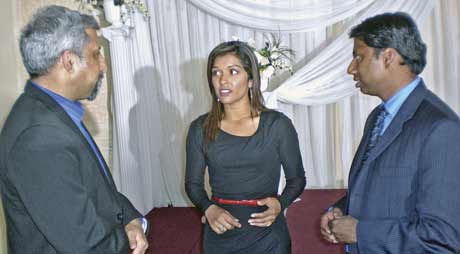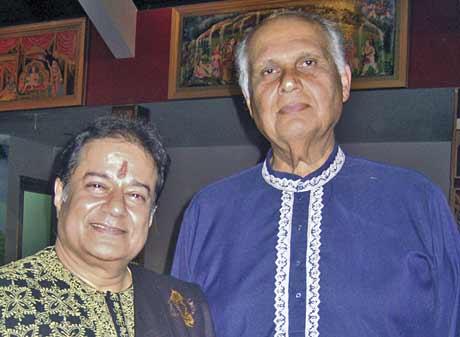Maintain a 'white society'

By William Doyle-Marshall
This year's observance of South Asian Heritage Month came to a close with a powerful fund-raising dinner hosted by the Council of Agencies Serving South Asians (CASSA).
Patrons left the event mulling over some startling disclosure regarding Canada's past policies specifically designed to maintain a "white society" and prevent South Asians from coming to Canada. In addition there was an appeal for acknowledgment of the community's political, social and economic contributions to this country.
CASSA's tenth anniversary celebration of South Asian Heritage Month included a series of dances exhibiting Classical South Indian dances, Tamil folklore and Bengali cultural expression. Theepa Harold presented "Booimiyin Alagay, a classical dance from South India related to the Tamil language. Anojini Kumaradasan's presentation was "Kannan Varugindra Neram" part of Tamil folklore heritage – a dance about anticipating Lord Krishna's arrival. Mondira Chowdhury performed a lively traditional Bengali dance. It captured the essence of a girl waking up from her dreams to welcome the heat of the summer.
Keynote speaker Dr. Ali Kazimi, an award winning documentary filmmaker and Associate Professor at York University talked about attempts to keep South Asians out of the country. In that regard the Province of British Columbia, in 1907 took away their right to vote. His extensive research exploring early South Asian history will be published in a forthcoming book "Undesirable: White Canada and the Komagata Maru".
It captures an era which starts with the Komagata Maru and the arrival of the MV Sun Sea.
Neethan Shan, CASSA's executive director told patrons his community doesn't want to just participate in South Asian Heritage Month in various places for the sake of participating.
"If police or the school boards or the justice system celebrate South Asian Heritage Month, we would like them to tell us how are they planning to eliminate the barriers that this particular community faces in accessing equal justice in all of these places because deep inside, the real commitment to acknowledging a particular community is to say there are particular barrier that are there that needs to be removed," he emphasized.
The audience heard that from 1867 to 1967 Canada had a policy that can only be described as a White Canada Immigration Policy. It was modeled after the White Australia Policy which Australia declared when it became a Commonwealth in 1901. South Asian women could not come to Canada, so there were less than ten women in a community of 6,000 people. Dr. Kazimi saw this as a way of discouraging permanent settlement.
The hysteria around South Asians coming to Canada reached a fever pitch in 1907 following a news wire report that a ship carrying 1100 Asian immigrants (900 South Asians, 200 were Japanese and Chinese) were arriving here, the film maker observed. It is very similar to the resonances of today about ships coming, he theorized.
An organization called the Asiatic Exclusion League quickly formed a mob and went on a rampage through the Chinese and Japanese quarters in Vancouver. That is known as the Race Riots of Vancouver, September 11 and 12, 1907 which resulted in tremendous property damage.
"Japanese actually fought back and repelled the mob while the police stood aside with complete complicity of the City administration. The consequences of this riot was it led to the complete exclusion of South Asians which was the irony of this event," Dr. Kazimi continued.
McKenzie King who later became Canada's longest serving Prime Minister, as a young man, was sent by Sir Wilfred Laurier to investigate the riots. After paying off all the Japanese and the Chinese claims, Dr. Kazimi said, he was sent to the U.K. to find out how Canada could block South Asian immigration.
After returning, King created the Continuous Journey regulation, which says to come as an immigrant to Canada you must do so by continuous journey from your country of birth or citizenship. This sounds pretty neutral, no mention of race, unlike the Chinese head tax but what's sent out at the same time, Dr. Kazimi discovered in the archives, is a secret memorandum to all the immigration officers saying: this regulation applies only to the most undesirable of immigrants – codified as meaning South Asians.
"The continuous journey regulation is one of the most effective anti-immigrant tools ever devised by any country. Immigration dropped from 2600 people from South Asia in 1907 to less than a dozen in 1908. It kept at pretty much those levels til 1913 when 39 men arrived and were detained under the Continuous Journey Regulation because they hadn't come by continuous journey and the Canadian Government had made it impossible to do a continuous journey.

By Arti Panday
With the sky high cost for dialysis in Guyana, Vishnu Mandir's Global Outreach Program is opening a Renal Awareness and Dialysis Centre where the goal is to provide treatment to everyone.
On May 27, 2011, the Global Outreach Program looked to the community to contribute to the cause through a benefit concert starring Anup Jalota.
Involved with other humanitarian events prior to this, Jalota acknowledged the importance of contributing to a cause associated with medical treatment before beginning the concert.
Melodious tunes filled the night as Anup Jalota sang passionately with a hand-picked band that helped entertain a mesmerized audience of around 200 people.
With the assistance of various Canadian organizations including the Humber River Regional Hospital and McMaster University, progress on the dialysis centre is well under-way.
"This is a complicated project where there are many facets to cover," said Dr. Budhendra Doobay, Head of the Vishnu Mandir which is spearheading the project. "We have to organize the water treatments, nurses, technicians, and getting all of the new supplies to Guyana from Canada."
The project is being supported by many organizations in Canada. Nephrologists from McMaster University have volunteered to help with the cause and Canadian nurses will be going to Guyana to train the health professionals. In addition, a technician from Humber River Regional Hospital was sent to Guyana to check on the ten dialysis machines on site.
Aside from the Renal Awareness and Dialysis Centre which is set to open in Annandale E.C.D., Guyana, the Global Outreach Program is assisting in the development of the Paediatric and Neonatal Intensive Care Unit at the Georgetown Public Hospital.
Dr. Narendra Singh is the Chief of Paediatrics at Humber River Regional Hospital and is heading the neonatal project for the Global Outreach Program.
The medical director of the Georgetown Public Hospital in Guyana, Dr. Rambaran, was also present on Friday evening. "Throughout the past 5 to 6 years we've been strengthening our relationship with Canada," said Dr. Rambaran. He later included that they are, "looking to establish a post-graduate program in Paediatrics."
With the privately owned dialysis centre currently in Guyana charging $180 per visit, this program will provide treatment for a more affordable cost.
"People are now recognizing kidney disease in Guyana and we want to create a centre where people are able to receive proper treatment," said Dr. Doobay. "The mission for the dialysis centre is to treat everyone regardless of race, religion, creed, or ability to pay."
Besides the centre in Annandale, the program is providing the Georgetown Public Hospital with two dialysis machines, water treatment equipment and nephrologists in order to make the treatment more accessible.
Consumables for one thousand treatments have been purchased from India and are expected to arrive in Guyana by the beginning of July.
The Global Outreach Program is working in full force to get everything in order, with hopes that the Renal Awareness and Dialysis Centre as well as the dialysis centre at Georgetown Public Hospital will be ready to start treatment by the end of July.